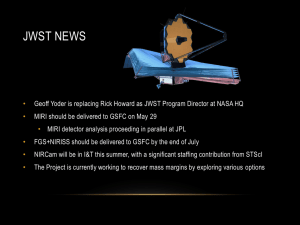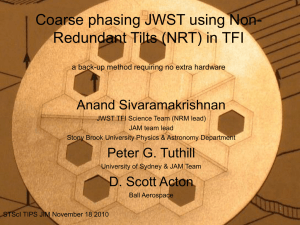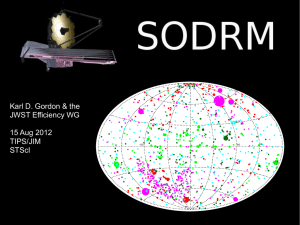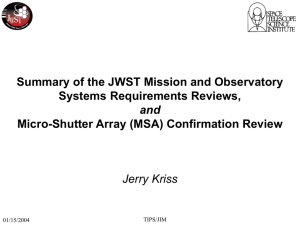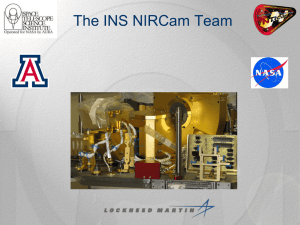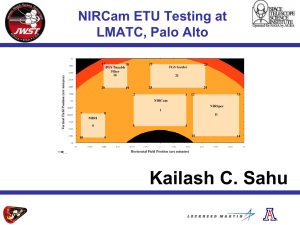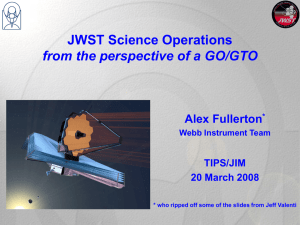Summary of the JWST MIRI and NIRCam Systems Requirements Reviews Jerry Kriss TIPS/JIM
advertisement
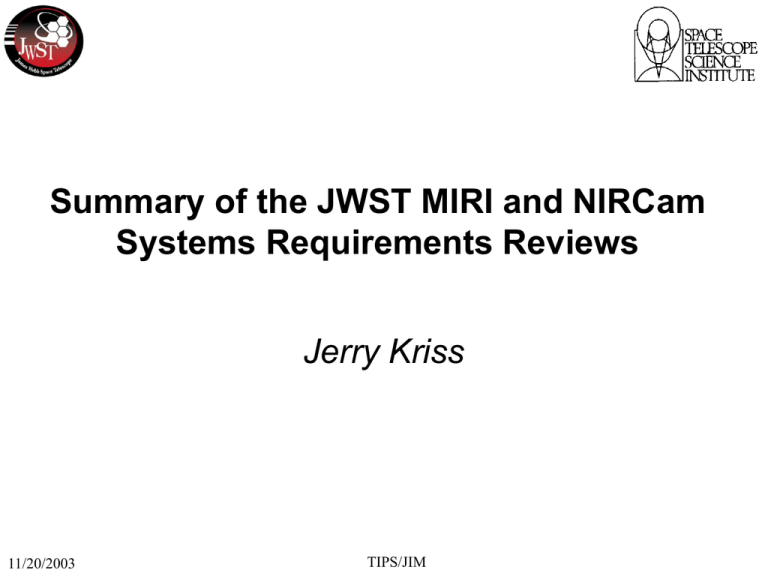
Summary of the JWST MIRI and NIRCam Systems Requirements Reviews Jerry Kriss 11/20/2003 TIPS/JIM Objectives of MIRI & NIRCam SRRs Establish the baseline for subsequent design and verification activities by identifying instrument requirements and their pedigree. Confirm that instrument requirements and specifications meet the mission objectives. Communicate the formal SI requirements to the review teams and to the various groups and contractors involved in the JWST project. Identify issues and concerns and assign actions for investigating and resolving them. 11/20/2003 TIPS/JIM Requirements Flowdown to ISIM and Instruments JWST Level 1 Requirements JWST-RQMT-000633 Mission JWST Project Science Objectives and Requirements Document (JWST-RQMT-000804) Segment Mission Operations Concept Document JWST-RQMT-002018 JWST Observatory Specification DRD SE-03 JWST-SPEC-002020 Observatory to Ground Segment ICD DRD SE-09 JWST-ICD-001998 Element Observatory to Ground Segment IRD DRD SE-07 JWST-IRD-000696 Mission Assurance Requirements for the JWST Instruments JWST-RQMT-002363 ISIM to NIRCam IRD JWSTIRD-000780 ISIM to NIRCam ICD JWST-ICD-000728 Sub-System NIRCam Science ISIM to OTE and Spacecraft IRD DRD SE-06 JWST-IRD-000640 ISIM Requirements JWST-RQMT-000835 NIRCam Specification JWST-SPEC-002049 ISIM to NIRSpec IRD JWSTIRD-000781 ISIM to NIRSpec ICD NIRCam Operations Concept (UAz DRD OPS-11) ISIM to MIRI IRD JWST-IRD-000782 ISIM to MIRI ICD JWST-ICD-000730 JWST-ICD-000729 MIRI Science Requirements NIRSpec FPRD JWST-SPEC-002060 ISIM Structure Requirements JWST-RQMT-002087 ISIM to OTE and Spacecraft ICD DRD SE-08 JWST-ICD-001831 NIRSpec Operations Concept NIRSpec Science Requirements Requirements UAz DRD SR-01 11/20/2003 JWST Mission (Level 2) Requirements JWST-RQMT-000634 MIRI FRD JWST-SPEC-002063 ISIM FSW Requirements JWST-RQMT-002101 TIPS/JIM ICDH Requirements JWST-RQMT-000743 MIRI Operations Concept FGS Operations Concept ISIM to FGS IRD JWST-IRD-000783 ISIM to FGS ICD JWST-ICD-000727 FGS Science Requirements FGS Specification JWST-SPEC-002069 MIRI & NIRCam SRR Timing (1 of 2) Requirements flowdown is largely complete • IRDs in final CCB process • Driving open issues identified and plan for resolution exists • Requirements worked with the teams extensively over last 18 months These SRRs Precede Mission/Obs/ISIM SRR • Formal (i.e. CCB) requirements flowdown from Mission- to SI-level documentation is not yet complete This exception to the “standard” process allows MIRI & NIRCam development to proceed on schedule to avoid threatening the JWST launch date 11/20/2003 TIPS/JIM MIRI & NIRCam SRR Timing (2 of 2) Risks posed by this approach are mitigated through: • Science Working Group, which includes the Instrument PIs, has defined the Mission-level Science Requirements • PIs ensured consistency between Mission- & Instrument-level Requirements • SI Teams Participating in Working Groups which define Interface Requirements • • • • Interface Summit Meetings ISIM to Telescope Interface Working Group Line-of-Sight Working Group Wavefront Sensing Working Group • Drafts of all Requirements, Interface, Ops, & PA Documents have been Released • Extensive pre-CCB Coordination Ongoing – – • SI Teams are Reviewing Mission & ISIM-level Documents ISIM is Reviewing Instrument-level Documents PIs and/or SI Team Leads are on Project- and ISIM-level CCBs • Configuration control process in place for future changes: PI is on Project and ISIM-level CCB. 11/20/2003 TIPS/JIM MIRI SRR Review Team Frank Schutz, Co-Chair Dennis Dillman, Co-Chair Klaus … , Co-Chair Steve Scott Paolo Strada Dr. David Leckrone + several others … 11/20/2003 JPL GSFC System Review Office ESA GSFC Chief Engineer ESA GSFC Space Sciences TIPS/JIM MIRI Plays a Key Role in Origins Roadmap Traceability of MIRI Science and Roadmap Investigations Imaging Investigation 1. Pristine gas, the first stars, and the first heavy elements 2. Black holes and structure in the early Universe 3. Formation and evolution of galaxies 4. Lifecycle of stars in the Milky Way and other galaxies 5. Habitats for life in the Milky Way and other galaxies 6. Molecular clouds as cradles for star and planet formation 7. Emergence of stellar systems 8. Evolution of protoplanetary dust and gas disks into planetary systems R~3000 R~100 CoronaSpec- Specgraphy trosco troscopy ** X* X* X* X* X* X* X* X* X* X* X* X* ** ** 9. Evidence of planets in disks around young stars X* 10.Census of planetary systems around stars of all ages 11. Chemical and physical properties of giant extrasolar planets 12. Detect giant planets by direct imaging, and study their properties 13., 14., 15., 16. Not major JWST impact * Identified as a MIRI key investigation by the Origins Subcommittee ** JWST SWG has found MIRI has an important role 11/20/2003 TIPS/JIM X* X* X* ** X* X* Example 1: MIRI Will Identify True First Light Objects 1000000 30 Flux (nJy) • Models of spectral energy distributions* show that NIRCam may have difficulty distinguishing true first light galaxies from those with older stars, or even quasars! • MIRI data beyond 5mm can remove this uncertainty ** first light older galaxy quasar frst lght, filters older, filters quasar, filters 10 1000003 10 2 5 10 1 Wavelength (microns) ** drives sensitivity for 5.6, 7.7mm photometry * technical details in the box below the figure 11/20/2003 Modeled young galaxies and a typical quasar, all at z = 15. The Lyman a forest attenuates their outputs short of Ly a and foreground damped Lyman a systems cause reddening of AV = 0.6 for the first light object and AV = 0.4 for the older galaxy. The horizontal bars indicate the NIRCam and MIRI filter bands and the relative signal levels that would be detected through them, offset for clarity. Error bars of + 10% are also shown as fiducials. TIPS/JIM Example 2: MIRI Sees Through Interstellar “Windows” to Explore Protostars and Their Environments MIRI beam @ 7mm CIRCUMSTELLAR DISK DUSTY ENVELOPE PROTOSTAR ~ 500 AU 11/20/2003 November 4-5, 2003 orbit of Pluto TIPS/JIM The interiors of protostellar cocoons must be probed in the mid-infrared: two windows in the interstellar extinction near 7 and 15mm provide a unique opportunity to see deep inside. Example 3: MIRI Will Explore Nearby Planetary Systems and Debris Disks MIRI view of Vega system at 24mm (model from Wilner et al. 2000) Adequate to probe detailed predictions of dynamical models and study the planet that drives them 11/20/2003 TIPS/JIM Driving Requirements • Operations Support four science modes Efficiency • Optical Support four science modes Wave front errors, stability Fields of view, pixel scales Spectral properties (filters, resolutions, etc.) Throughput, scattered and stray light rejection, minimization of artifacts Coronagraphic rejection - basic design, pointing • Signal Chain Sensitivity parameters - read noise, QE, dark current of detectors Radiometric properties - stability, linearity, dynamic range • Thermal Background for sensitivity - OBA < 15.5K Sensitivity of detectors - SCAs < 6.9K Lifetime > 5 yrs Detector anneal 11/20/2003 TIPS/JIM MIRI Review Summary The review board judged that the review did not fulfill its goals. Too many unresolved issues: • Dewar mass (20 kg over) or lifetime (3.9 yrs vs. 5 required) • Pupil alignment errors (5.4% vs. 2%) could lead to increased background or lower throughput (by 30%). • Required depth of focus is now larger than can be accommodated by MIRI design (3 mm vs. 2 mm). • Lingering concerns about the divided NASA/ESA management structure. • General concerns about unsettled higher-level requirements flowing down to the instrument level late in the process and increasing costs. 11/20/2003 TIPS/JIM NIRCam SRR Review Team Dennis Dillman, Chair Marty Davis Tom Venator Steve Scott Joe Schepis Gene Waluschka Sachi Babu Tony Miller Dr. David Leckrone 11/20/2003 GSFC System Review Office GSFC Project Management GSFC Instrument Systems/Mechanical GSFC Chief Engineer GSFC Electromechanical Systems GSFC Optics GSFC Detectors GSFC Electrical Systems GSFC Space Sciences TIPS/JIM NIRCam’s Role in JWST’s Science Themes The First Light in the Universe: NIRCam NIRCAM_X000 Modern Universe Clusters & Morphology Reionoization First Galaxies Recombination Forming Atomic Nuclei Inflation Quark Soup Discovering the first galaxies, Reionization NIRCam executes deep surveys to find and categorize objects. Period of Galaxy Assembly: Establishing the Hubble sequence, Growth of galaxy clusters NIRCam provides details on shapes and colors of galaxies, identifies young clusters Stars and Stellar Systems: Physics of the IMF, Structure of pre-stellar cores, Emerging from the dust cocoon NIRCam measures colors and numbers of stars in clusters, measure extinction profiles in dense clouds young solar system Kuiper Belt Planets 11/20/2003 Planetary Systems and the Conditions for Life: Disks from birth to maturity, Survey of KBOs, Planets around nearby stars NIRCam and its coronagraph image and characterize disks and planets, classifies surface properties of KBOs TIPS/JIM NIRCam Science Requirements (1 of 2) Detection of first light objects, studying the epoch of reionization requires: 5-s 50,000 secs • High spatial resolution for distinguishing shapes of galaxies at the sub-kpc scale (at the diffraction limit of a 6.5m telescope at 2µm). 11/20/2003 TIPS/JIM z=5 HST z=10 NIRCam 0.1 0.5 1.5 2.5 3.5 4.5 l(m m) Performance of adopted filter set Number of Filters 4 5 6 Number of Filters 4 5 6 7 4 Number of Filters Observing the period of galaxy assembly requires in addition to above: 10 SIRTF 1 • Fields of view (~10 square arc minute) adequate for detecting rare first light sources in deep multi-color surveys. • A filter set capable of yielding ~4% rms photometric redshifts for >98% of the galaxies in a deep multi-color survey. Keck/VLT 100 nJy • Highest possible sensitivity – few nJy sensitivity is required. 1000 5 6 7 8 0.00 1<Z<2 0.05 2<Z<5 0.10 |Zin-Zout|/(1+Zin) 0.15 5<Z<10 0.20 NIRC_X0052 NIRCam Science Requirements (2 of 2) Stars and Stellar Systems: • High sensitivity especially at l>3mm • Fields of view matched to sizes of star clusters ( > 2 arc minutes) • High dynamic range to match range of brightnesses in star clusters • Intermediate and narrow band filters for dereddening, disk diagnostics, and jet studies • High spatial resolution for testing jet morphologies Planetary systems and conditions for life requires: • Coronagraph coupled to both broad band and intermediate band filters • Broad band and intermediate band filters for diagnosing disk compositions and planetary surfaces 11/20/2003 TIPS/JIM NIRC_X0044 Derived Requirements (1 of 2) nJy (10-35 W/m2/Hz) sensitivity • Detectors with read noise < 9 e-, Idk<0.01 e/sec QE>80% • Focal plane electronics with noise < 2.5e- so detector performance is not degraded • High throughput instrument: 70% for optics, 85% for filters At least 7 broadband filters for redshift estimates Large Field of View • Dichroics to double effective FOV • Large format detector arrays Large well-depth on detectors 11/20/2003 TIPS/JIM Derived Requirements (1 of 2) High spatial resolution • Nyquist sampling at 2mm and 4mm Selection of intermediate and narrowband filters • 8 R~10 filters needed to classify ices, cool stars • At least 4 R~100 filters for key jet emission lines (want higher spatial resolution than Canadian tunable filters) Coronagraph required in all modules • Coronagraph most important at long wavelengths • Coronagraphic field must not reduce survey FOV Need fluxes calibrated to 2% • Requires gain stability on week time scales • Requires on-orbit calibration plan using on stars 11/20/2003 TIPS/JIM NIRCam’s Descope Paths (1 of 2) Descopes which would result in the largest savings (e.g., reducing array size from 4Kx4K to 2Kx2K, single rather than dual wheels) precluded by WFS requirements. Could reduce number of filters and/or eliminate coronagraphy but this saves little. Could drop redundancy requirement within each FPE box Could accept degraded detector or optical coating performance. • This would be a descope for late in instrument development where poorer than required performance would be accepted to maintain schedule • Impact unlikely to exceed a factor of 1.5 given current levels of detector performance and assuming that essentially no AR coatings were used. • Not acceptable for cost savings now 11/20/2003 TIPS/JIM NIRCam’s Descope Paths (2 of 2) Only removal of the dichroics and dedicated long wavelength channels yields any significant savings. Descope would remove: • 2 of 4 dual filter/pupil wheels • 2 of 10 2Kx2K Focal Plane Arrays • 2 dichroics • 2 lens assemblies (but note that remaining lens assemblies now have to work over 0.6-5µm rather than only collimators working over the full range) • 2 fold flats • 2 of 10 Focal Plane Electronics cards 11/20/2003 TIPS/JIM Descope Plan: Science Impacts Science impacts of removal of dedicated long wavelength arms are significant: • Time to execute any multi-color observation would more than double because of having to observe all wavelengths serially rather than in parallel. The data return from NIRCam would effectively be cut in half. • Ability to characterize icy surfaces and cool stars would be lost because only one filter wheel is available and there would be too few slots for as many intermediate band filters as NIRCam has now. • Long wavelength sensitivity would be degraded (10-s point source detection limit changes from 18.9 nJy in 10000 sec to 20.5 nJy at 4.5µm because of oversampling of the PSF). 11/20/2003 TIPS/JIM NIRCam Review Summary The review board approved of NIRCam moving on toward PDR, but noted several concerns: • NIRCam wave-front error exceeds its allocation (70 nm vs. 56 nm). • NIRCam mass exceeds its allocation (7.7 kg out of 140 kg). • Concerns about ghosts in a largely refractive optical design. • Detector procurement has no independent V&V plan. • Worried about possible complexities of event-driven operations. 11/20/2003 TIPS/JIM Lessons Learned (Preliminary) Note: Official review board reports and lists of accepted RFAs have not yet been issued. Out-of-order reviews makes review boards suspicious. Presentation style matters: a requirements review should focus on requirements and their flowdown. • MIRI team highlighted problems, glossed over the successes • MIRI team got bogged down in design details Clear, decisive management structure helps. Mission and ISIM SRRs in December may be tough. 11/20/2003 TIPS/JIM
